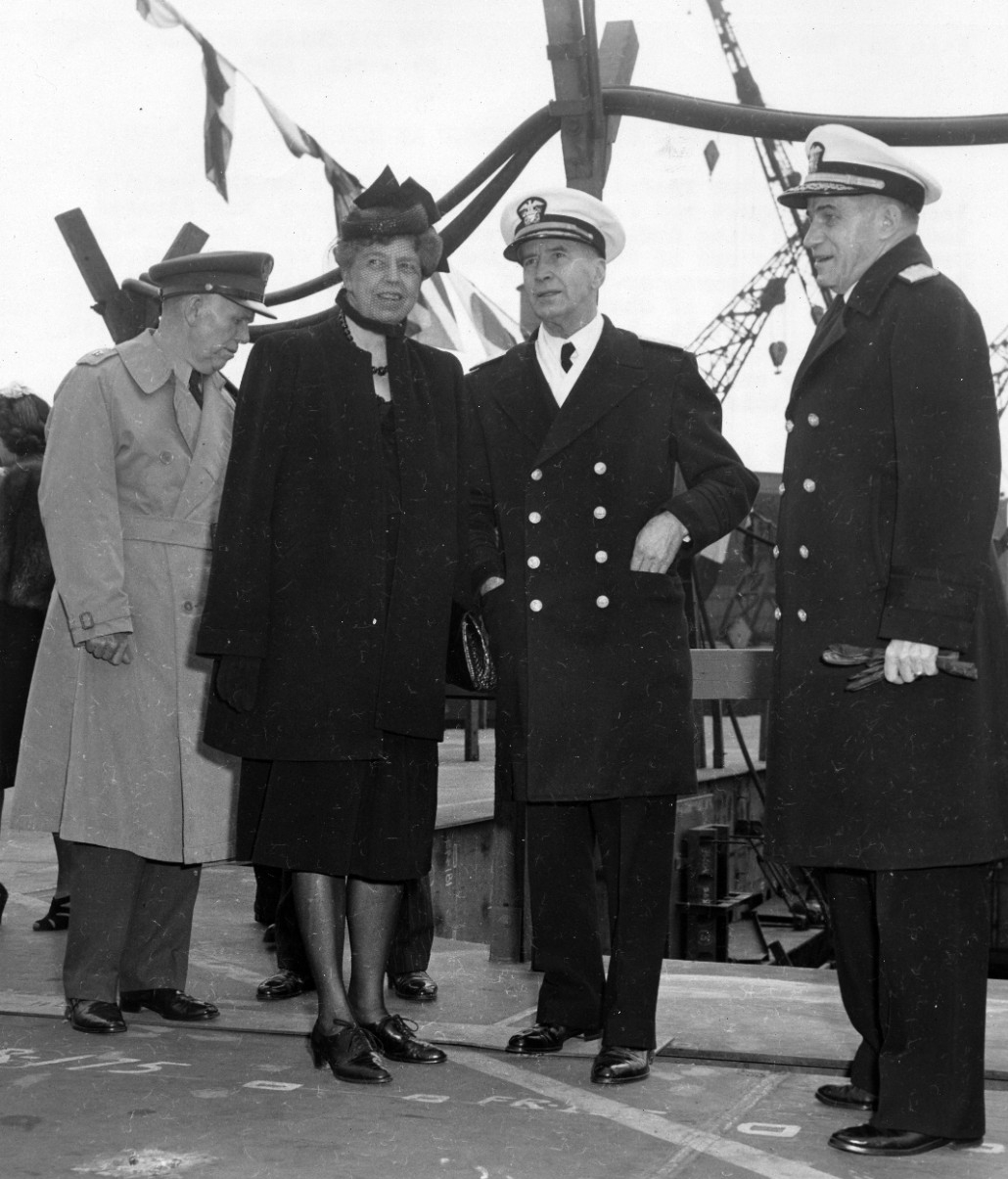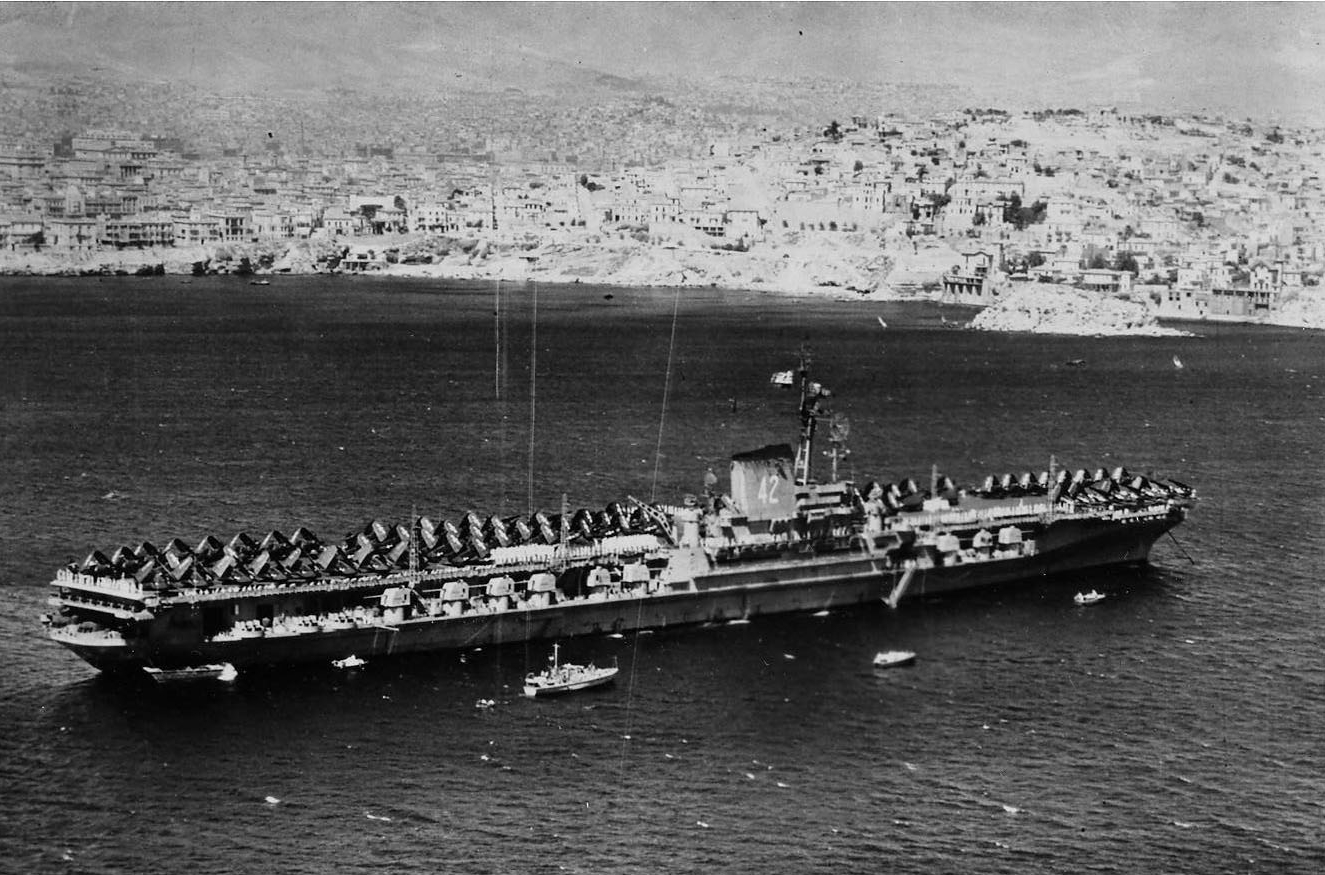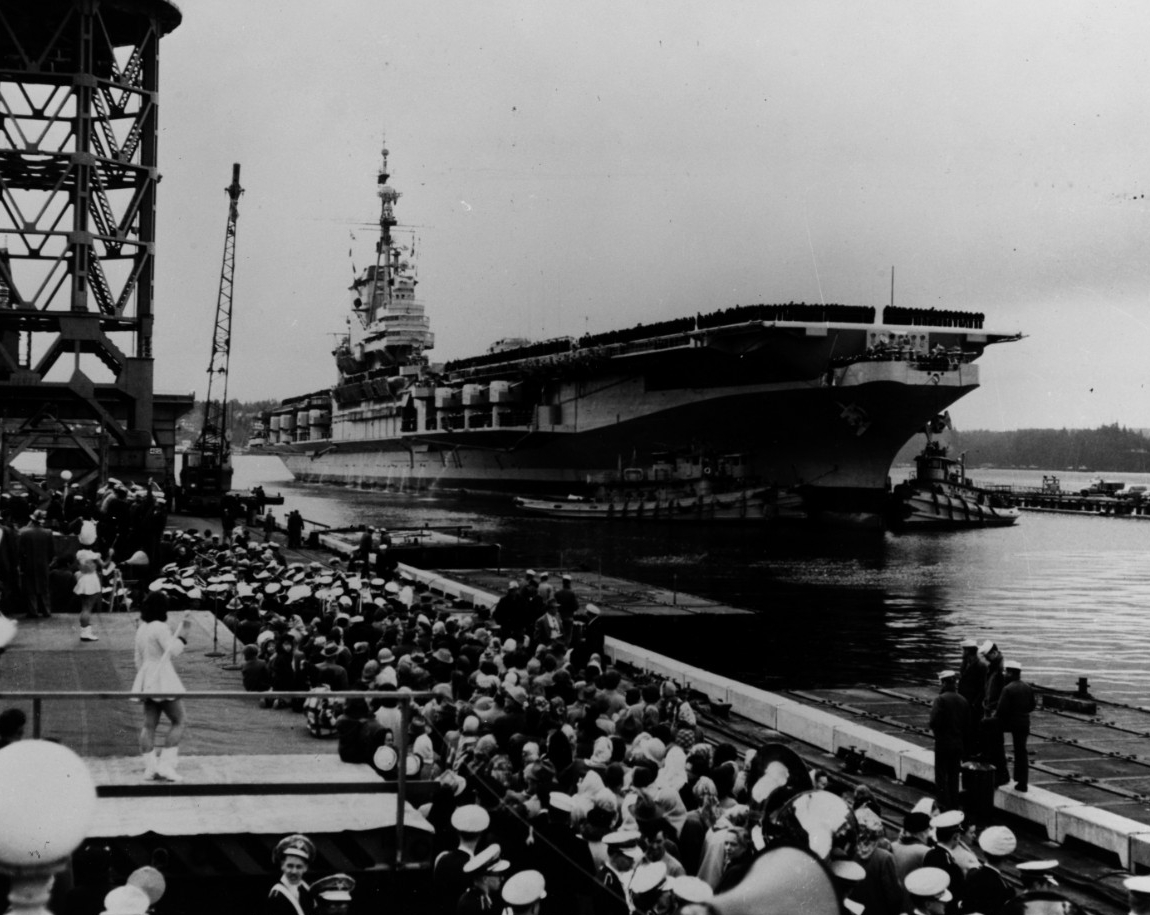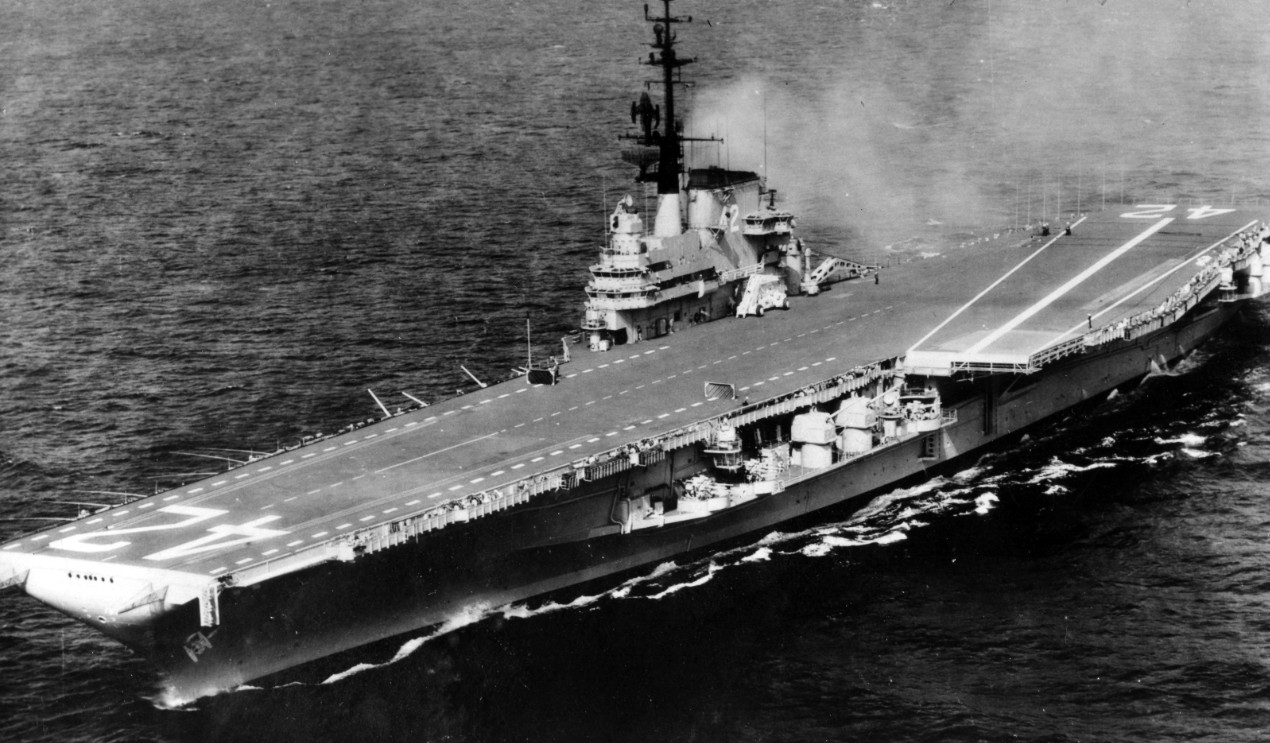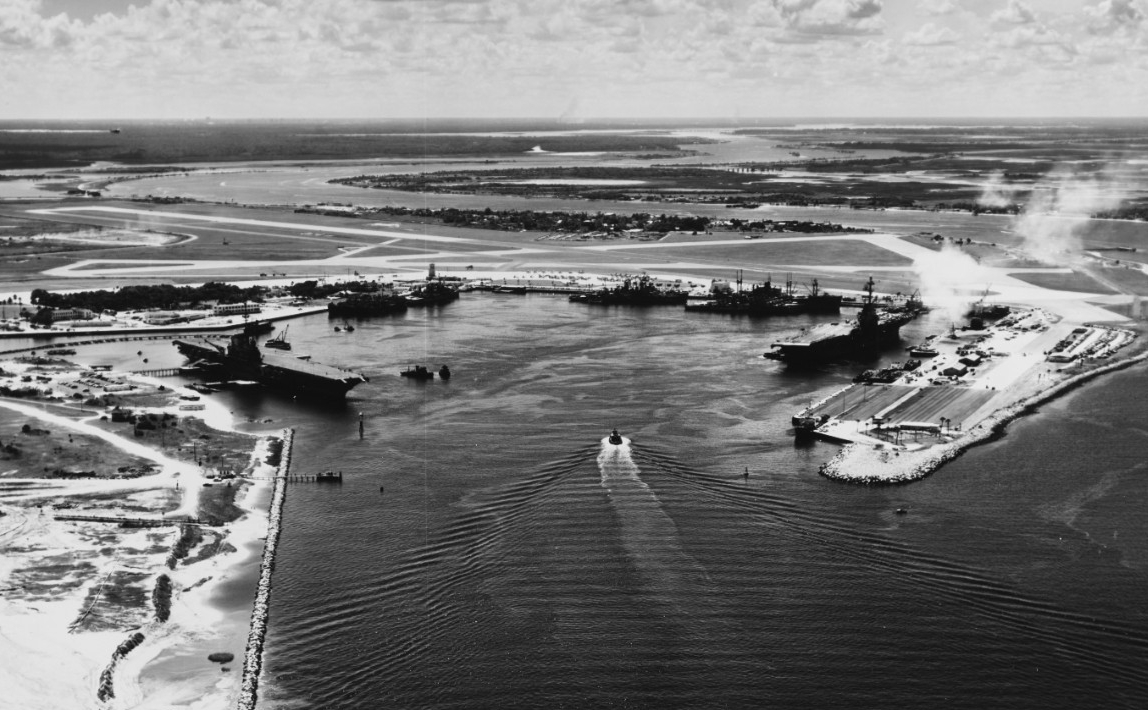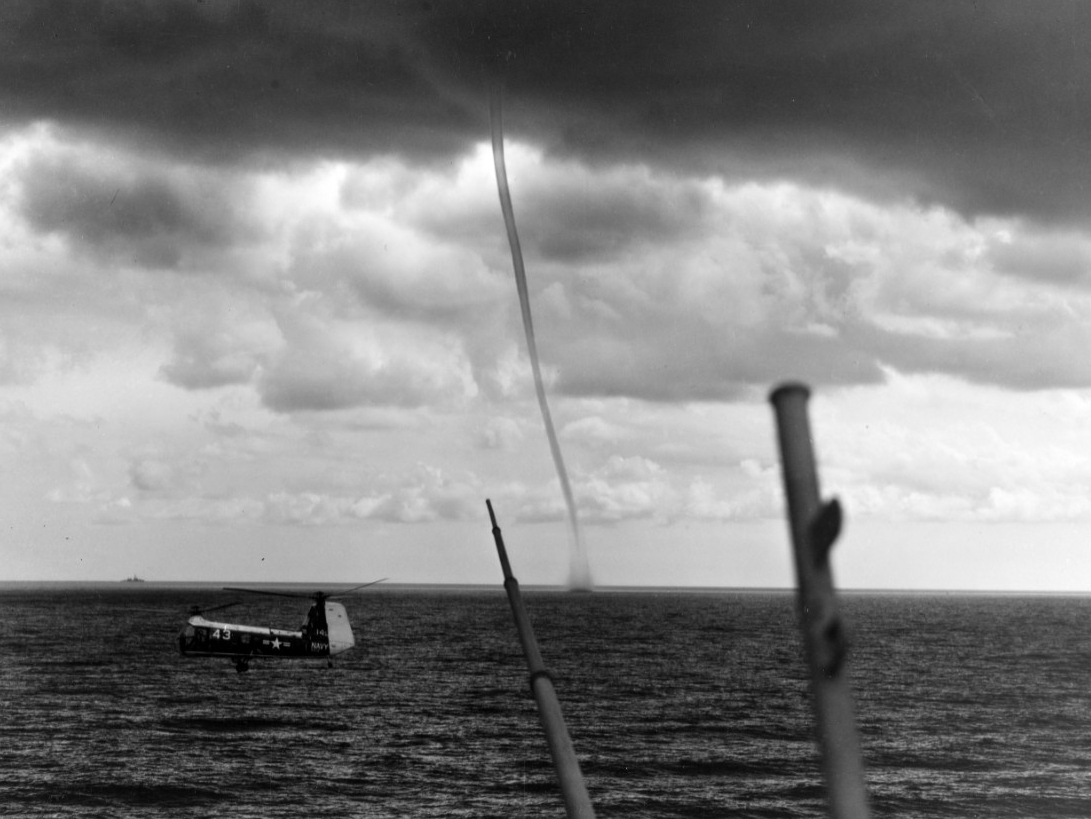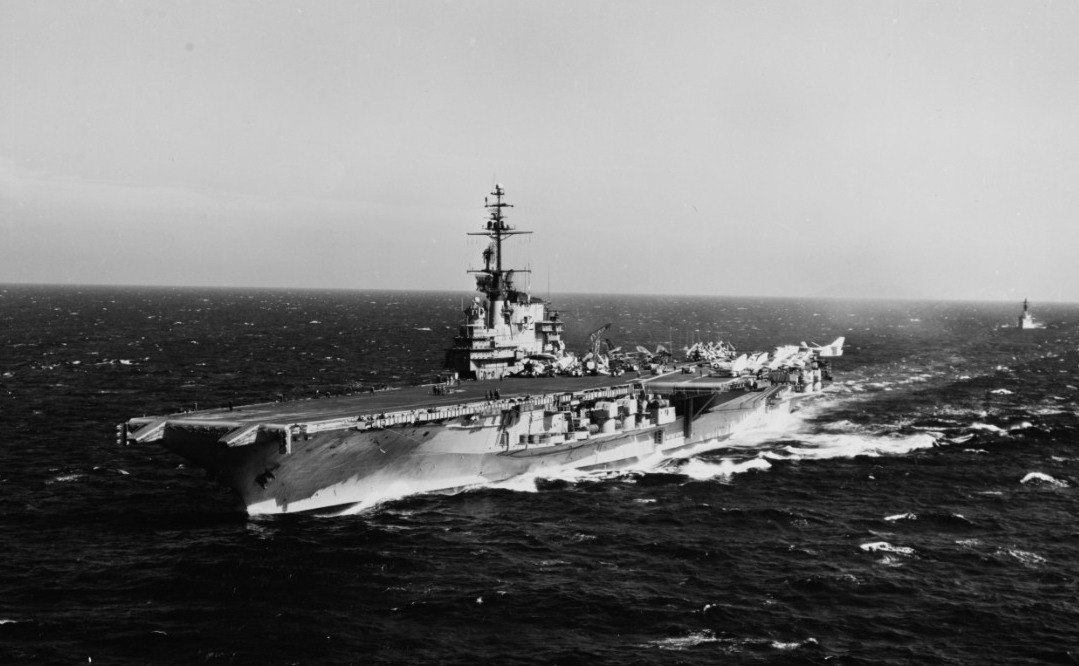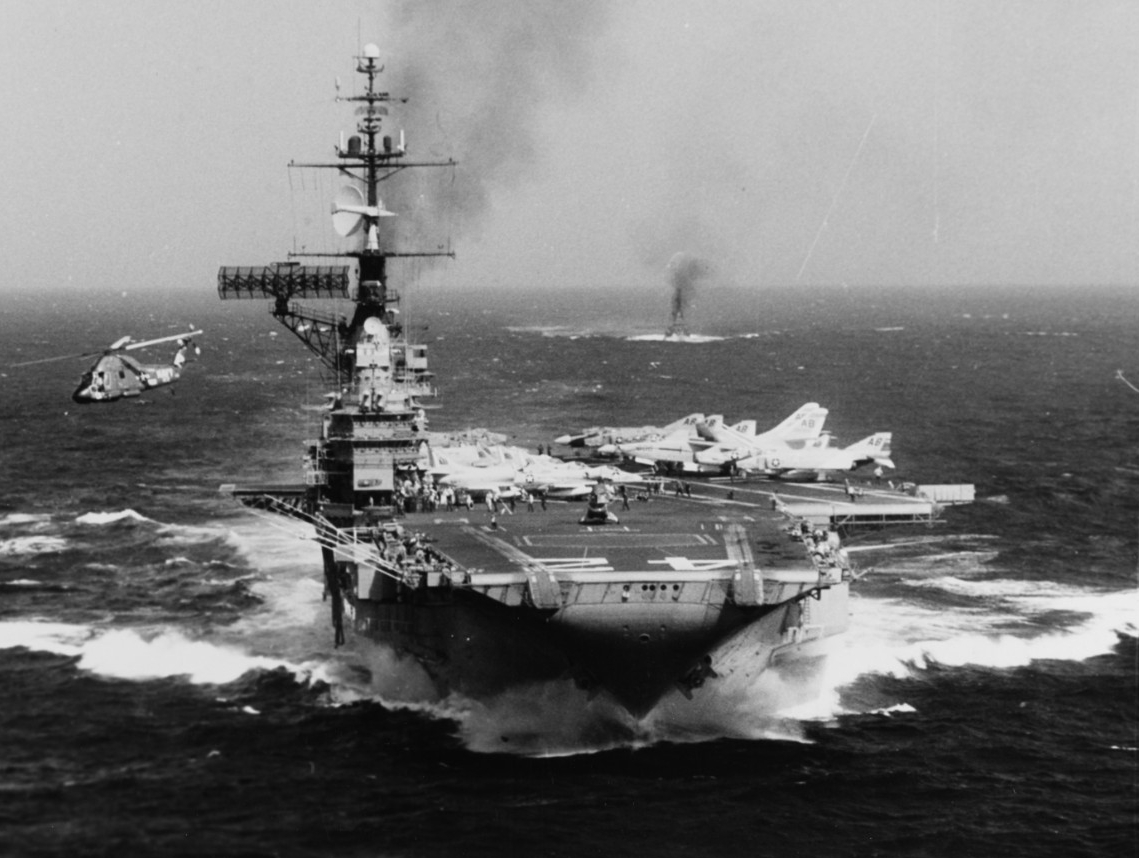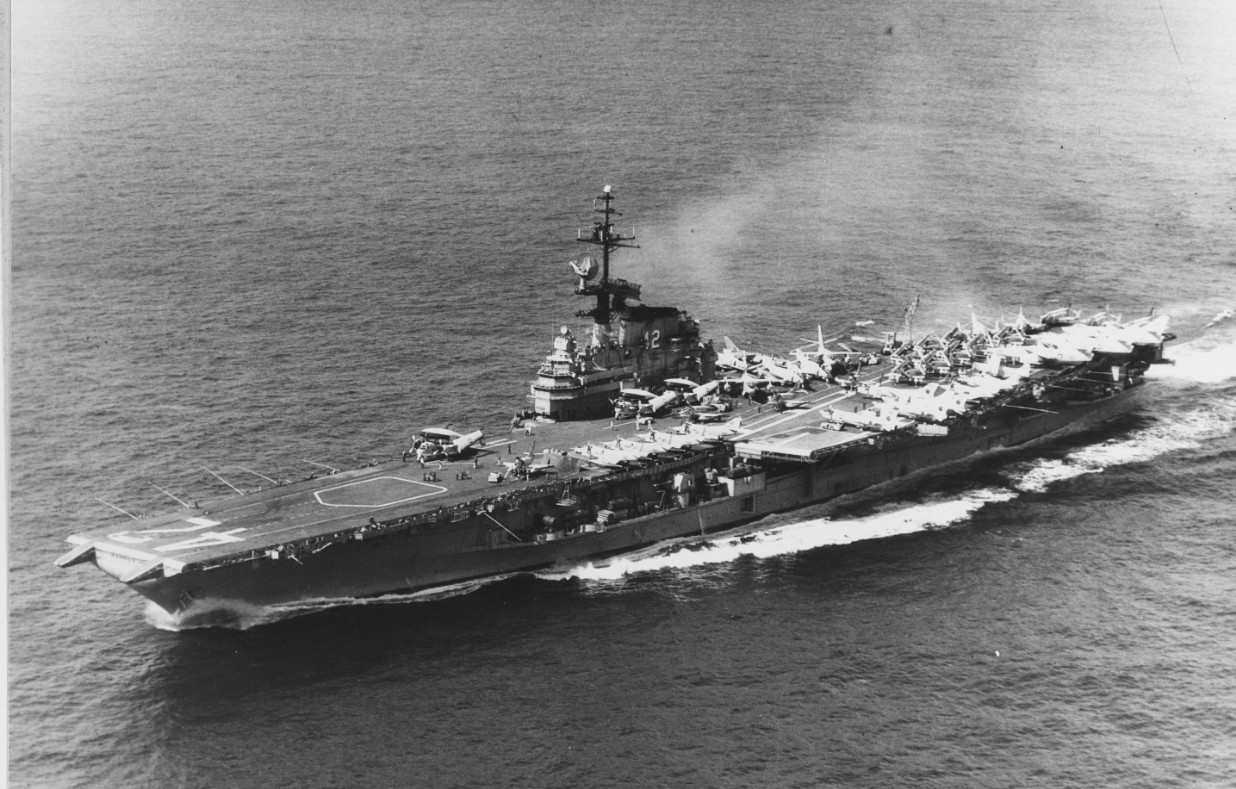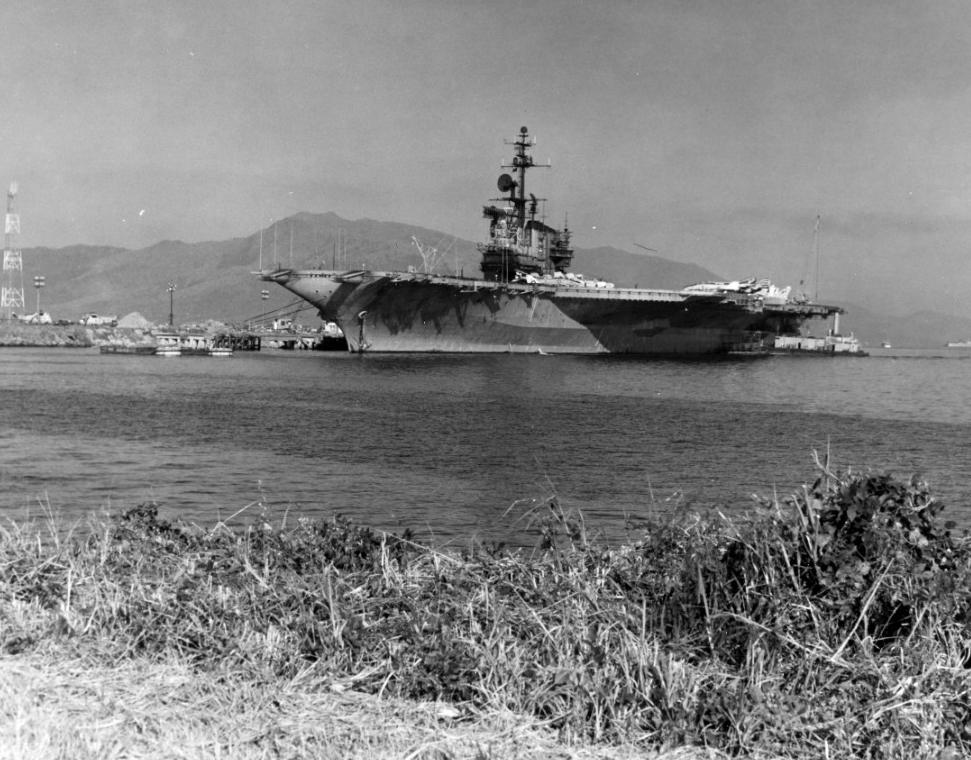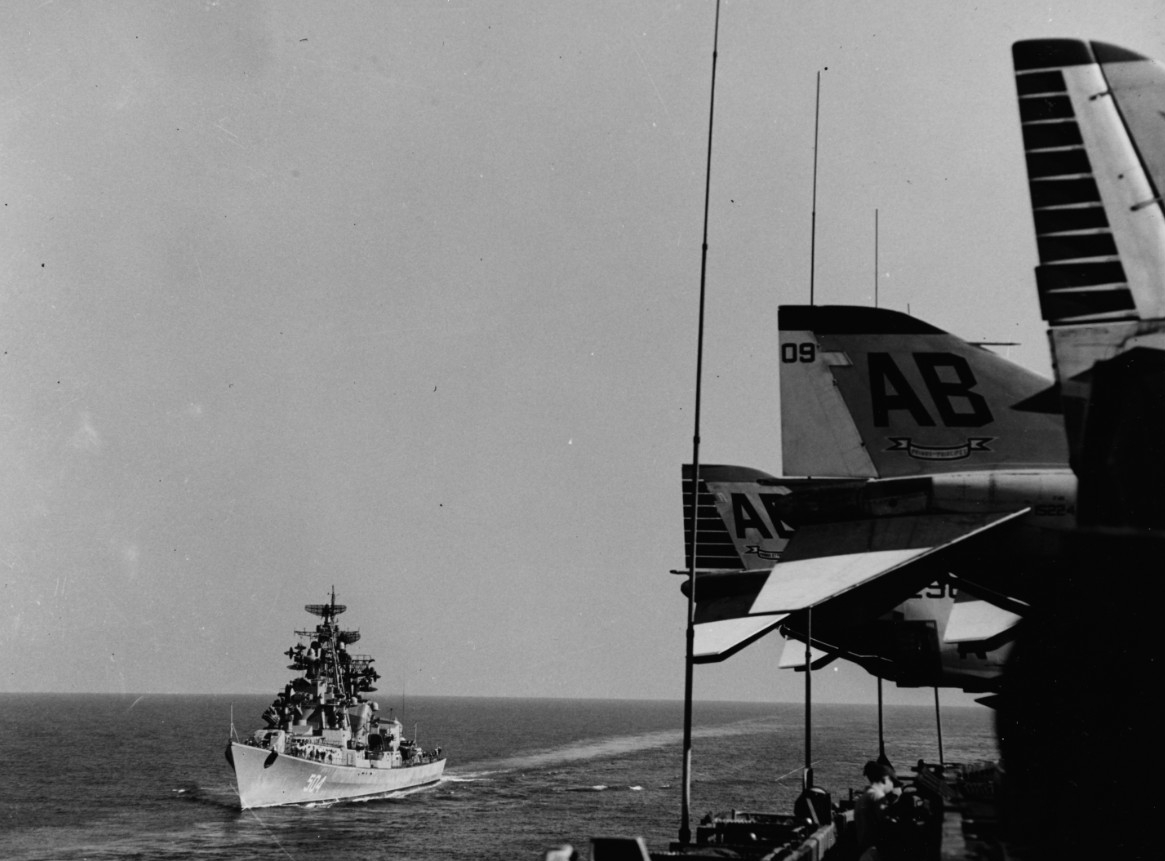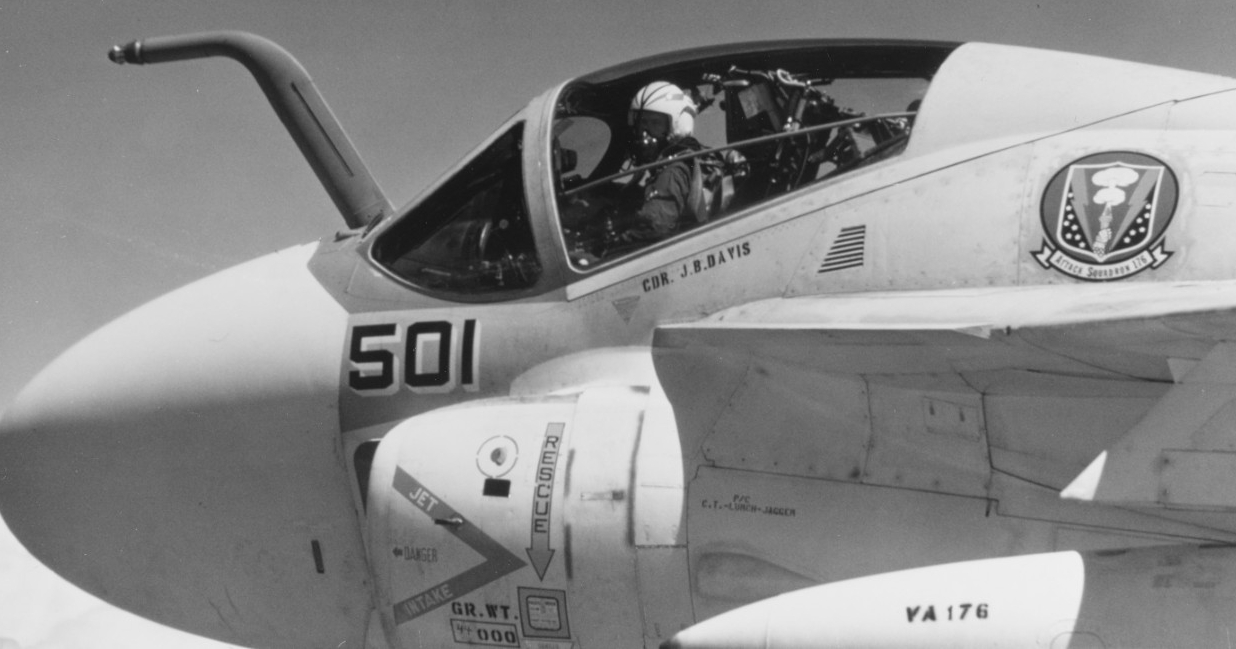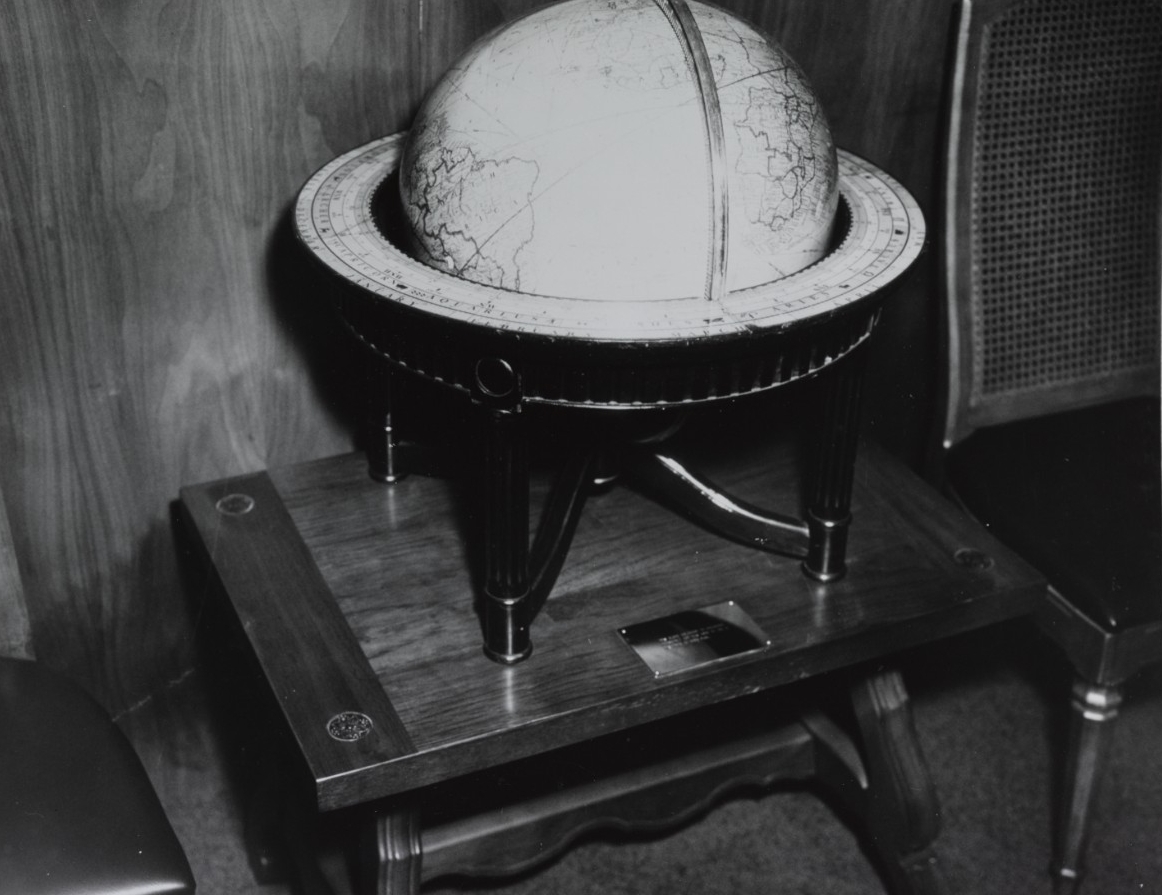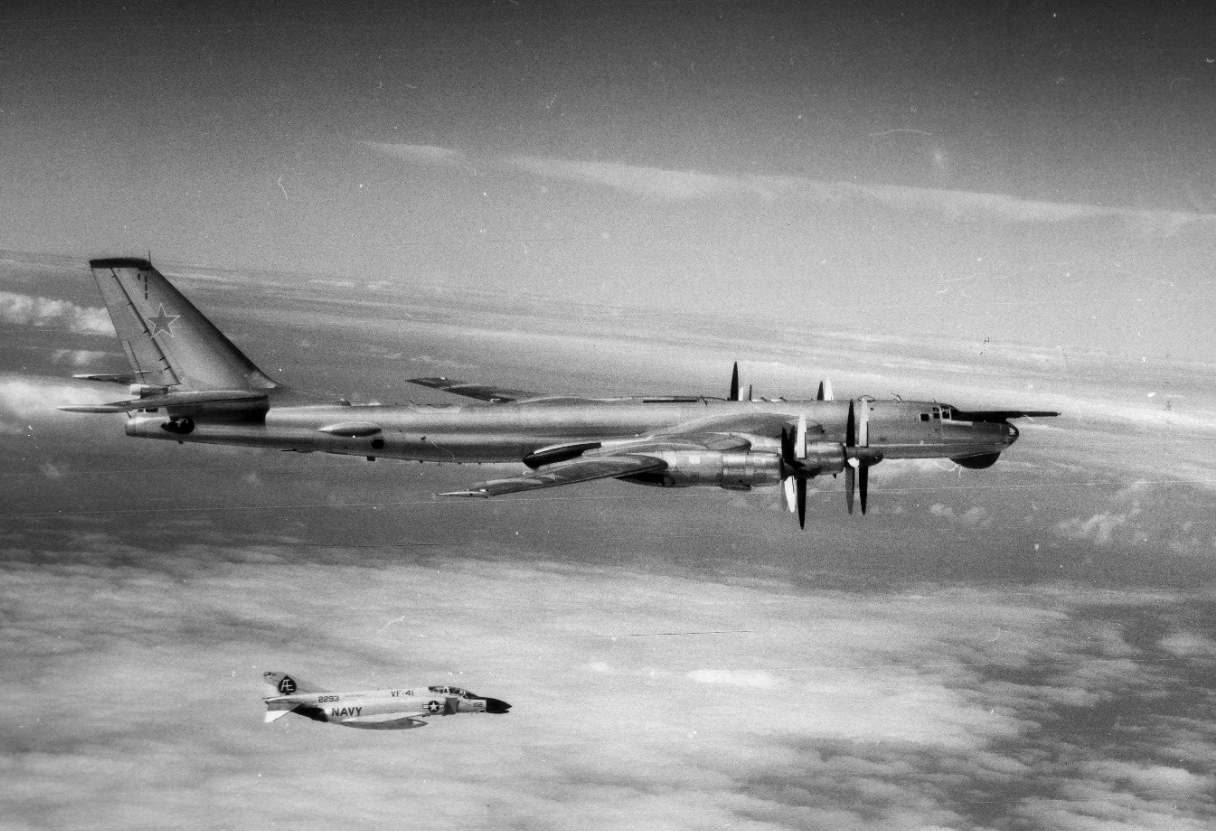Franklin D. Roosevelt (CVB-42)
1945–1977
Franklin Delano Roosevelt (30 January 1882–12 April 1945), the 32nd President of the United States (4 March 1933–12 April 1945).
(CVB-42: displacement 45,000; length 968'; beam 113'; extreme width 136'; draft 35'; speed 33 knots; compliment 4,104; armament 18 5-inch, 84 40-millimeter; aircraft 137; class Midway)
Coral Sea (CVB-42) was laid down on 1 December 1943, at the New York Navy Yard, Brooklyn, N.Y.; launched on 29 April 1945; sponsored by Mrs. Anne P. Towers, née Pierette, wife of Adm. John H. Towers, Commander Air Force, Pacific Fleet, and by the ship’s honorary sponsor, First Lady A. Eleanor Roosevelt; renamed Franklin D. Roosevelt to honor the late President Roosevelt on 8 May 1945, marking the first time that the Navy made an exception to the traditional naming of fleet aircraft carriers for battles or famous ships; and commissioned on 27 October 1945, Capt. Apollo Soucek in command.
Franklin D. Roosevelt set out on her shakedown cruise with Large Carrier Air Group (CVBG) 75 embarked into the Caribbean and South Atlantic (8 January–19 March 1946). Douglas H. Fox (DD-779) screened the carrier at times, and the destroyer’s sojourn into the southern waters proved fortuitous when she rescued two aircrewmen on 17 January. Lt. Norman K. McInnis and ARM2c Eldridge E. Taylor attempted to take off in Aircraft No. 7, a Curtiss SBC2-4E of Bombing Squadron (VB) 75 but crashed. The ship had way on and horrified onlookers watched as she steamed over the Helldiver but both men miraculously escaped and Douglas H. Fox rescued them. Franklin D. Roosevelt called at Rio de Janeiro, Brazil (1–11 February) to represent the United States at the inauguration of Brazilian President Eurico G. Dutra, who boarded the ship for a short cruise. Douglas H. Fox in the meanwhile refueled briefly at Trinidad in the British West Indies on 26 January and Pernambuco in Brazil on 31 January.
Following Franklin D. Roosevelt’s return to the United States she became the Eighth Fleet’s flagship and took part in maneuvers off the east coast (April–May). On 24 April President Harry S. Truman, Fleet Adm. William D. Leahy, Fleet Adm. Chester W. Nimitz, and Vice Adm. Marc A. Mitscher led an entourage on board Franklin D. Roosevelt to review the Eighth Fleet off the Virginia capes. A K-class airship flew directly over Franklin D. Roosevelt during the exercises, affording the ship’s company a unique view of lighter-than-air operations.
The ship continued to make history and Lt. Cmdr. James J. Davidson successfully landed and took off (deck-launched without catapults) in a McDonnell XFD-1 Phantom on board Franklin D. Roosevelt on 21 July 1946. Davidson’s feat marked the first U.S. exercise to test the adaptability of jet aircraft to shipboard operations.
Franklin D. Roosevelt made the ship’s maiden deployment when she sailed with CVBG-75 to the Mediterranean (8 August–4 October 1946). While the ship lay anchored at Lisbon, Portugal, on 18 August she welcomed Houston (CL-81) as the light cruiser also slipped up the Tagus River into the port. Vice Adm. John H. Cassady, Commander Carrier Division 1, broke his flag in the carrier as she then (5–9 September) called at Piraeus near Athens as a show of support for the Greek government’s efforts to stem the tide of communism in the embattled country. Little Rock (CL-92), Cone (DD-866), Corry (DD-817), and New (DD-818) accompanied Franklin D. Roosevelt during the carrier’s visit, and United States Ambassador to Greece Lincoln MacVeagh boarded the ship upon her arrival on the 5th and met with Capt. Herbert E. Regan and his staff. As Franklin D. Roosevelt stood back out to sea she launched 78 aircraft over the task force in an impressive display of naval air power. On 30 September President Truman declared the permanency of the U.S. naval presence in the region, primarily to contain Soviet aggression. Franklin D. Roosevelt altogether gave thousands of Europeans an opportunity to view the ship during her calls to a number of Mediterranean ports. Following the ship’s brief maiden deployment she provided Americans the same opportunity when she put in to New York City during the Navy Day celebrations on 27 October.
Lt. Col. Marion E. Carl, USMC, completed two catapult launches, four free take-offs, and five arrested landings in a jet propelled Lockheed P-80A Shooting Star on board Franklin D. Roosevelt off the Virginia capes (1–11 November). These operations comprised part of an extensive investigation of the carrier suitability of jet aircraft that began on 29 June 1945, when a Shooting Star arrived at Naval Air Test Center Patuxent River, Md.
Franklin D. Roosevelt operated off the east coast until July 1947, when she entered Norfolk Naval Shipyard, Va., for a prolonged overhaul. The ship received a number of improvements to equipment and facilities, and 40 3-inch guns replaced her 40-millimeter mounts.
The ship and Carrier Air Group (CVG) 4 sailed from Norfolk for a second tour of duty with the Sixth Task Fleet in the Mediterranean (13 September 1948–23 January 1949). On 17 October a glimpse about the roadstead at Phaleron Bay off Piraeus revealed Franklin D. Roosevelt anchored in company with heavy cruiser Albany (CA-123), along with Little Rock, Providence (CL-82), and their destroyer screen.
During the next five years, Franklin D. Roosevelt took part in intensive operations off the Virginia capes, along the east coast, and in the Caribbean, and made four tours of duty to the Mediterranean. Franklin D. Roosevelt and CVG-6 kicked off some of the larger scenarios when they took part in a series of exercises in the North Atlantic (27 October–23 November 1949).
Cmdr. Thomas Robinson demonstrated carrier long-range attack capabilities when he used Jet Assisted take-Off (JATO) to launch in a Lockheed P2V-3C Neptune from Franklin D. Roosevelt while she steamed off Naval Air Station (NAS) Jacksonville, Fla., on 7 February 1950. Robinson flew over Charleston, S.C., the Bahamas, the Panama Canal, up the coast of Central America, and over Mexico, landing the following day at the Municipal Airport at San Francisco, Calif. The flight covered 5,060 miles in 25 hours, 59 minutes—the longest to date made from an aircraft carrier’s flight deck.
The ship and CVG-6 deployed to the Mediterranean (10 January–18 May 1951), and following the usual round of upkeep and training set out with CVG-17 to the North Atlantic and Mediterranean (26 August–19 December 1952). Franklin D. Roosevelt’s latter voyage coincided with a momentous operation. The Allied Atlantic Command, led by Adm. Lynde D. McCormick, of the North Atlantic Treaty Organization (NATO), carried out its first large scale naval exercise in the North Atlantic during Operation Mainbrace (14–25 September). A number of naval commands participated as part of NATO’s forces including the Second Task Fleet, Vice Adm. Felix B. Stump, and Allied Forces Northern Europe, British Adm. Sir E. J. Patrick Brind, RN. Gen. Matthew B. Ridgeway, USA, the Supreme Allied Commander Europe, also too part.
Tens of thousands of allied servicemembers participated including 80,000 American, Belgian, British, Canadian, Danish, Dutch, French, Norwegian, and Portuguese sailors and marines, as well as nearly 1,000 aircraft, and more than 200 vessels including battleship Wisconsin (BB-64), Franklin D. Roosevelt, Midway (CVB-41) with CVG-6, Wasp (CV-18) and CVG-1, British battleship Vanguard (23), British aircraft carriers Eagle (R-05) and Illustrious (87), small aircraft carrier Wright (CVL-49), Canadian light aircraft carrier Magnificent (CVL-21), British light fleet aircraft carrier Theseus (R-64), escort aircraft carriers Mindoro (CVE-120) and Salerno Bay (CVE-110), Amphibious Group 2’s flagship Mount Olympus (AGC-8), Columbus (CA-74), Des Moines (CA-134), and Quincy (CA-71), British light cruiser Swiftsure (08), Canadian light cruiser Quebec (C-31), and destroyer tender Tidewater (AD-31).
Franklin D. Roosevelt embarked CVG-17, consisting of the McDonnell F2H-2 (F-2) Banshees of Fighter Squadrons (VF) 171 and VF-172, Vought F4U-4 Corsairs of VF-174, Douglas AD-4/L Skyraiders of Attack Squadron (VA) 175, AD-4Ws of Composite Squadron (VC) 12 Detachment 42, AD-4N (A-1D)s of VC-33 Detachment 42, F2H-2Ps of VC-62 Detachment 42, and a Piasecki HUP-1 (UH-25A) Retriever of Helicopter Utility Squadron (HU) 2 Detachment 41.
Allied planners postulated a scenario in which the Soviets and their proxies attacked the Norwegians and the Danes in an attempt to break out into the North Atlantic from the Arctic around the North Cape and from the Baltic Sea. Allied ships steamed into the North Sea, Baltic Sea, Norwegian Sea, and Barents Sea. Deploying the multiple carriers in the exercise demonstrated the importance that planners gave to maritime air power as they battled to hold the strategically vital Northern Flank. Mainbrace aircraft supported Allied ground forces, and carriers launched air strikes against enemy forces that attempted to capture Bodø, Norway, and against armored columns that pushed toward the Kiel Canal. A number of NATO ships also accomplished antisubmarine, amphibious, and shore bombardment operations along the Scandinavian coast. A heavily escorted convoy brought reinforcements from Scotland to Bergen, Norway, demonstrating the urgency to swiftly reinforce and resupply the Norwegians in the event of a war.
Some of the ships and aircraft maneuvered as far north as 68° and the cold weather challenged them so severely that the NATO carriers curtailed their flight operations by an estimated 80%. Meteorological conditions also compelled the amphibious forces to shift their objectives. In spite of these handicaps Mainbrace emphasized the importance of the Northern Flank and contributed to the NATO decision to establish the Atlantic Striking Force. So many vessels operating in proximity inevitably risked accidents and Coates (DE-685) collided with Tidewater at one point in the exercise. The destroyer tender sustained superficial damage though she tore a 20-foot square hole in the escort ship’s hull, and the later slid into the Firth of Forth in Scotland for repairs. Further inland near the West German village of Sennelager, not far from Paderborn, nearly 60,000 Belgian, British, Canadian, and Dutch troops counterattacked a simulated enemy thrust across the border in Operation Holdfast.
Franklin D. Roosevelt was reclassified to an attack aircraft carrier (CVA-42) on 1 October 1952. The ship next took part in Longstep in the Eastern Mediterranean. Allied Forces Southern Europe, Adm. Robert B. Carney, led Longstep, ten days in November when NATO forces responded to a simulated Soviet attack against the Greeks and Turks. Vice Adm. Cassady, now Commander Allied Naval Forces South, along with Maj. Gen. David M. Schlatter, USAF, Allied Air Force South, and Italian Lt. Gen. Maurizio L. De Castiglioni, Allied Land Forces Southern Europe, orchestrated the maneuvers to counterattack and repel the invaders. American, British, French, Greek, Italian, and Turkish servicemembers, 170 ships, and nearly 700 aircraft took part, including the Douglas A3D-1 (A-3A) Skywarriors of Heavy Attack Squadron (VAH) 3 that reinforced the group on board Franklin D. Roosevelt. The Third Battalion, Second Marines, formed part of the 3,000 amphibious troops (American, French, Greek, and Italian) that wrapped-up the exercise by landing south of İzmir, Turkey. The ship called at a number of ports during her voyage in the Mediterranean, and the crew spelled out “Vive La France” on the flight deck off Nice, France, on 24 October.
The increasingly seasoned carrier, with CVG-1 embarked, returned to the Mediterranean (11 June–3 December 1953). Following that deployment, the ship received orders assigning her to an extensive conversion at Puget Sound Naval Shipyard at Bremerton, Wash. The carrier thus sailed from Norfolk for the west coast (7 January–3 March 1954). Too large to pass through the Panama Canal she rounded turbulent Cape Horn, long considered the bane of mariners, and passed up the Americas’ Pacific coast. Stopping at Balboa in the Panama Canal Zone and on 3 March at San Francisco, the warship continued on to the shipyard, where she arrived on the 5th and was decommissioned on 23 April 1954.
Workers at Puget Sound fitted Franklin D. Roosevelt with an angled flight deck, two C-11-1 and one C-11-2 steam catapults, mirror landing system, hurricane bow, and AN/SPS-8 height finding and AN/SPS-12 air search radars on a new mast, as part of a SCB-110 reconstruction plan. Workers also removed some of her 5-inch guns, and the added measures increased her standard displacement to 51,000-tons. Franklin D. Roosevelt was re-commissioned at the shipyard on 6 April 1956, Capt. John T. Hayward in command. The carrier returned to sea and on 16 June arrived at San Francisco to load stores for her voyage around the Horn to Mayport, Fla., and arrived at her new home port on 8 August.
The U.S. received information on 6 November 1956, that the Soviets intended to deploy six ships from the Black Sea to the Eastern Mediterranean. Just four minutes before midnight the Joint Chiefs of Staff ordered Forrestal (CVA-59), Franklin D. Roosevelt, a cruiser, and three divisions of destroyers to the vicinity of the Azores Islands to reinforce the Sixth Fleet. Adm. Arleigh A. Burke, CNO, in the meanwhile dispatched Coral Sea and Randolph to steam off the Egyptian coast, from where they could support the evacuation of Americans or strike against the Soviets. Submarines deployed to reconnaissance stations, and antisubmarine warfare aircraft and ships patrolled multiple areas across the Atlantic and Mediterranean. The operations by the Sixth Fleet during subsequent weeks included the logistic support of the initial UN peacekeeping forces that arrived in the area on 15 November. Franklin D. Roosevelt returned home from the tense voyage on 9 December 1956, and on the 13th the Sixth Fleet stood down from a 24-hour alert status.
In February 1957, Franklin D. Roosevelt sailed to the Gulf of Maine for cold-weather tests of catapults, aircraft, and other carrier equipment, including the SSM-N-8 Regulus (Regulus I) cruise missile. In July she sailed for the first of three post conversion cruises to the Mediterranean through 1960. Her assignments in the Mediterranean added NATO exercises to her normal schedule of major fleet operations, and found her each year entertaining a distinguished list of guests. A constant emphasis on her stateside operations included developing advanced tactics and procedures.
Franklin D. Roosevelt trained about 100 miles off NAS Jacksonville on the afternoon of 19 June 1957. At 1242 the 4A main feed pump in No. 1 pump room ran away, causing the turbine motor to fly out and pieces blew through two bulkheads and caused a high-pressure steam line to burst. The ship reduced speed immediately in order to secure the boilers, and at least a half dozen aircraft in the air diverted from their intended landings on board the carrier and landed ashore. An A-3 Skywarrior could not lower its landing gear and crashed near the carrier basin at Mayport, but all three crewmen survived. The escaping steam killed two BTs on watch in an adjacent compartment, 22-year-old Bobby E. Hyder and 20-year-old Sydney R. Wall, and scalded five more crewmen: 24-year-old Lt. (j.g.) Donald E. Smith, 29-year-old Philip R. Plantier, 20-year-old Donald E. Brockman, 19-year-old Robert J. Radke, and Richard M. Haigh. Nearly 60 men entered the fierce steam to rescue the fallen, but heat prostration or exhaustion struck down 29 men, many of them as they attempted to help their fellows.
“I can’t pinpoint one single man [for heroism],” Capt. Thomas W. Hopkins, the ship’s commanding officer, reflected, “all are equally deserving of praise.”
The ship moored just after 0100 on the 20th at Mayport, and two ambulances took Hyder and Wall to a Jacksonville funeral home that contracted with the Navy for such sad occurrences. A Navy air-sea rescue plane flew the injured men to Naval Hospital NAS Jacksonville for further medical treatment. Despite the tragedy the ship’s company resolutely resumed the regimen of preparing for war but spelled out “Peace on Earth” on the flight deck on Christmas Eve 1957.
The fighting between Cuban revolutionaries led by Fidel R. Castro and the government troops of Gen. Fulgencio Batista y Zaldivar threatened Americans living within Nicaro [Nicaro-Levisa, formerly Lengua de Pajaro]. The State Department therefore ordered the evacuation of U.S. nationals from the port on 23 October 1958. The following day Franklin D. Roosevelt provided distant air cover while high speed transport Kleinsmith (APD-134) (ex-DE-718) rescued 56 Americans and three foreigners. The ship also carried out an overhaul in 1958, which included removing the last 22 of her 3-inch guns.
Franklin D. Roosevelt and CVG-1 deployed to the Sixth Fleet in the Mediterranean (13 February–1 September 1959). The Douglas F4D-1 (F-6A) Skyrays of Marine All Weather Fighter Squadron (VMF(AW) 114 deployed with the air group, and the ship and her aircraft took part in a number of NATO exercises including Green Swing in April. Following Franklin D. Roosevelt’s return from the deployment she continued to train and refueled from oiler Pawcatuck (AO-108) off the Virginia capes on 4 October 1959. The ships collided during the refueling, slightly damaging both vessels, though neither reported casualties.
Workers installed the Fresnel Lens Optical Landing System on board the ship in 1960, and she moreover embarked CVG-1 and sailed for the Mediterranean (28 January–24 August 1960). Following that deployment the ship carried out the usual round of voyage repairs and upkeep, scheduled or deferred maintenance, and training operations to prepare her for further deployments. Franklin D. Roosevelt and CVG-1 wrapped up those cycles and once more charted a course for the Sixth Fleet in the Mediterranean (15 February–28 August 1961). The voyage proved a significant one in that Franklin D. Roosevelt celebrated her 100,000th aircraft landing that March.
Life at sea is nonetheless dangerous and flight operations doubly so. The ship’s Pilot’s Landing Aid Television (PLAT) captured frightening moments that gained public attention in later years, and one in particular circulated among veterans. Lt. (j.g.) John T. Kryway of VF-11 launched in Aircraft No. 212, a Vought F8U-1 (F-8A) Crusader (BuNo 145357), from Franklin D. Roosevelt while she trained in the Caribbean on 21 October 1961. Heavy swells caused the ship to heel and pitch and presented a daunting proposition for Kryway, an experienced pilot. As Kryway completed his flight and returned to Franklin D. Roosevelt the ship rolled in a swell and his jet slammed the flight deck on the starboard main mount and broke off the wheel. The impact thrust the wheel up into the Crusader’s wheel well and ruptured the main fuel line and the fuel caught fire. The jet hurtled down the carrier blazing and over the port angled flight deck. The PLAT video vividly shows the jet as it quickly dropped into the sea and Kryway ejected, and then just as quickly descended in his partially deployed canopy (parachute) dangerously close to the ship’s port side while she still had way on. Kryway’s harness gave him an abrasion on his neck but he was rescued from the water and survived the harrowing accident.
Dominican President Joaquín Balaguer declared a state of emergency following the return to that country of Héctor and José Trujillo, brothers of assassinated President (Gen.) Rafael Trujillo on 18 November 1961. Franklin D. Roosevelt subsequently reinforced the Caribbean Ready Amphibious Squadron off the coast of the Dominican Republic. The combined force launched flights of A4D Skyhawks and made amphibious feints from outside Dominican waters to emphasize U.S. resolve to prevent a reestablishment of a dictatorship in the Dominican Republic. The ships came about following the formation of a Dominican Council of State on 19 December.
Franklin D. Roosevelt and CVG-1 deployed once more to the Sixth Fleet in the Mediterranean (14 September 1962–22 April 1963). On 28 September the ship worked with TG 60.8 after she crossed the Mediterranean and prepared to relieve Enterprise (CVAN-65) at Souda Bay, Crete. The two carriers competed for training awards and Capt. Gerald E. Miller, Franklin D. Roosevelt’s commanding officer, recalled that as “the underdog and smaller ship, we got pretty well charged up on this and we thought a lot about how we were going to do it.” Franklin D. Roosevelt and Enterprise began an exercise on opposite ends of the Ionian Sea. As the seconds ticked away toward midnight and the beginning of the scenario, Franklin D. Roosevelt launched some aircraft, shut down her radar and electronic systems, and slipped into the constricted waters on the eastern side of the island of Corfu to mask the ship’s radar signature. Aircraft discovered Enterprise and alerted a destroyer, which in turn notified Franklin D. Roosevelt, and Miller coyly noted that the latter “waxed” her famed nuclear powered counterpart as her engineering team scrambled to answer the bridge’s signals and the ship increased to flank speed and surprised Enterprise.
Following the ship’s return from the deployment she underwent another overhaul, during which workers removed six 5-inch guns. In addition, the Navy redesignated CVGs to Carrier Air Wings (CVWs) on 20 December 1963. Franklin D. Roosevelt and the newly renamed CVW-1 completed their preparations and deployed to the Sixth Fleet (28 April–22 December 1964). On 29 September Franklin D. Roosevelt sustained damage to her No. 1 propeller while operating in the Mediterranean. Independence (CVA-62) relieved Franklin D. Roosevelt and she subsequently came about and returned to the United States to repair the screw while in dry dock.
Cmdr. James R. Williford III piloted a Sikorsky SH-3A Sea King from Hornet (CVS-12) while the carrier lay berthed at NAS North Island, Calif., on 6 March 1965. Following a flight of 15 hours, 51 minutes Williford landed on board Franklin D. Roosevelt while the carrier maneuvered at sea off Naval Station (NS) Mayport. His flight surpassed the existing distance record for helicopters by more than 700 miles.
Franklin D. Roosevelt and CVW-1 deployed to the Sixth Fleet in the Mediterranean (28 June–17 December 1965). Franklin D. Roosevelt and 2,097-ton French merchantman Charles le Borgne, carrying a mixed cargo for Algiers, Algeria, collided off southern France, about 100 miles southeast of Marseille, on 12 October. The carrier sustained little damage and continued to participate in Lafayette IX, a two-day bilateral U.S.-French exercise in the Western Mediterranean. The impact ripped a large hole in the merchantman’s bow, however, and she proceeded under her own power to Marseilles, France, escorted by Douglas H. Fox.
The ongoing fighting in the Vietnam War compelled the Navy to rotate carriers through deployments to the Western Pacific. Franklin D. Roosevelt and CVW-1 thus turned toward the war. Prior to setting out the ship accomplished upgrades to improve her fighting capabilities, which included the welcome addition to the crewmen of installing air conditioning in key living and work spaces to endure the tropical heat. Their voyage carried them down the South Atlantic, around the Cape of Good Hope and across the Indian Ocean, and into the Western Pacific and the fighting (21 June 1966–21 February 1967).
Franklin D. Roosevelt and her embarked air wing sailed with 11 operational (of an allowance of 12) McDonnel Douglas F-4B Phantom IIs of VF-14, a dozen Phantom IIs of VF-32, 12 Douglas A-4E Skyhawks of VA-12, 14 A-4Es of VA-72, 14 A-4Cs of VA-172, four RF-8G Crusaders of Light Photographic Reconnaissance Squadron (VFP) 62 Detachment 42, a trio of Grumman E-1B Tracers of Carrier Tactical Electronics Warfare Squadron (VAW) 12 Detachment 42, four KA-3B tankers of Heavy Attack Squadron (VAH) 10 Detachment 42, and Aircraft No. 761, a single Grumman C-1A Trader (BuNo 136761) used as a Carrier Onboard Delivery (C.O.D.) plane. In addition, Angel 01 and Angel 02, the ship’s Kaman UH-2A Seasprite rescue helicopters (BuNos 149031 and 149758, respectively), and Angel 03, a UH-2B (BuNo 152206), all from Helicopter Combat Support Squadron (HC) 2 Detachment 42, kept busy flying plane guard for what evolved into a heavy tempo of flight operations, standing by in the event that any of the aircraft ended up in the water.
Franklin D. Roosevelt slipped her mooring lines at Carrier Pier 1 at NS Mayport shortly after noon on the 21st of June and turned southward. An Operational Readiness Inspection Team boarded at St. Thomas in the Virgin Islands, and the team put the crew through their paces as they drilled them in tactical scenarios that they might expect to face in the Vietnam War while they steamed in the Roosevelt Roads Operating Area off Puerto Rico (28–30 June).
The ship also found herself in the midst of a political controversy concerning human rights. Franklin D. Roosevelt was going to cover a vast distance and would need to refuel at some point, and a number of planners anticipated that the most likely opportunity would occur while she rounded the Cape of Good Hope.
The American civil rights movement and the South African government’s apartheid policy, however, produced tension between the two countries. Midway (CVA-41) and CVG-1 had sailed on a global circumnavigation (27 December 1954–14 July 1955) and called at Cape Town, South Africa, on 15 January 1955, but in May 1965, South African officials cancelled a planned visit by Independence because of her integrated crew. Then on 6 June 1966, Sen. Robert F. Kennedy spoke eloquently about individual liberty and human rights of both nations in his Day of Affirmation Address to National Union of South African students at Cape Town.
National Security Advisor Walt W. Rostow summarized the dilemma in a memo to President Lyndon B. Johnson on 22 June 1966: Franklin D. Roosevelt could refuel at Cape Town or from an oiler somewhere else in that region. Rostow queried Secretary of the Navy Paul H. Nitze on the subject and the secretary summarized his opinion of the alternatives:
1. “The attack carrier could refuel and have most satisfactory shore leave at Rio de Janeiro; but it means keeping the carrier on fighting station off Viet Nam an extra four days.”
2. “It could refuel from a tanker at Diego Suarez (Malagasy). The cost of sending out the tanker is between $100,000 and $200,000. Diego Suarez is a town of 4,500 people, all colored. At this moment the Navy says it would prefer to go straight through rather than have shore leave there.”
“Secretary Nitze,” Rostow elaborated, “concludes that you do have some flexibility here. The Navy would vastly prefer Capetown. But the ship going out contains fresh men, and shore leave is less important than it would be if they had been on battle station for some time. He says that the Navy’s willingness to forego shore leave at Diego Suarez indicates to him that the men’s situation is not desperate.”
“I access the risk of an unpleasant political situation as about 4 out of 10. The unpleasantness would be moderate, if we hit the 4,” he added.
Franklin D. Roosevelt meanwhile continued her voyage and the crew fittingly celebrated Independence Day by “crossing the line,” a time honored tradition, when the ship crossed the equator at 40°20'W, on 4 July 1966. The Shellbacks, those men who had already crossed at some point in their careers, initiated the Pollywogs, those who had not, in the nearly day-long ceremony. The Shellbacks inflicted an imaginative variety of indignities upon their victims including personalized haircuts, tossing them into a troth filled with scraps of food from the galley which acquired its own unique scent in the scorching tropical sun, and applying liberal doses of their Shillelaghs (cut lengths of fire hoses) to encourage the initiates along. The Pollywogs proudly emerged as Shellbacks and the ship’s newsletter noted that they accomplished the rite “cleansed of all traces of city dust and country sod,” though many men of both sides of the coin ended up with sunburn from the long event.
Planners continued to debate but decided to route Franklin D. Roosevelt through Rio de Janeiro and the ship visited the port and refueled (8–10 July). She then resumed her voyage southward, charted a course through the rough waters around the southern tip of Africa without stopping, and crossed the equator a second time on the 26th at 86°25'E. Franklin D. Roosevelt plowed across the Indian Ocean, passed through the busy Strait of Malacca that separates Indonesia, Malaysia, and Singapore, on across the South China Sea, and reached Subic Bay in the Philippines on the 1st of August. When the ship visited the port she generally moored at NAS Cubi Point. Following an all too fleeting five days of rest and recreation for the crew, and the opportunity to complete voyage repairs and refuel and provision, the ship steamed westward toward the war on 6 August.
Lt. Cyrus W. Strickler and Lt. (j.g.) Walter T. Scarboro, his Radar Intercept Officer, both men of VF-14, initiated the ship’s entry into combat when they launched first in their Phantom II on the morning of 10 August 1966. The men circled around and, joined by other fighters, flew protective Combat Air Patrol over Franklin D. Roosevelt and their naval aviation squadron mates as the ship sent her first strike of 13 aircraft aloft. Cmdr. Wendell K. Smith, Commander CVW-1, led a pair of Skyhawks of VA-72 that destroyed a highway bridge with 500-pound bombs. Other Skyhawks flew armed reconnaissance missions of communist supply routes and waterways. The ship’s planners orchestrated the first strike to launch within visual distance of the North Vietnamese coastline as a psychological blow to the enemy. Through the day more aircraft savaged their targets and Phantom IIs of VF-32 and Skyhawks of VAs 12, 72, and 172 knocked down spans of another bridge, cut the approaches to a river ford on a major highway, destroyed or damaged five large cargo barges, attacked two truck parks, blasted a transshipment warehouse, and perhaps most spectacularly, created a landslide that cascaded down onto a key mountain pass. North Vietnamese radio propagandists raised grim smiles on many pilots’ faces when they labeled them “air pirates” and “U.S. bandits.”
Typhoon winds mercilessly buffeted the ship throughout much of her wartime sojourn in the South China Sea. The heavy rain and low overcast repeatedly interfered with strikes against the enemy. Pilots often determinedly sought to find “a hole” in the weather through which they could bomb the equally determined North Vietnamese troops and insurgents. Ordnancemen nevertheless laboriously handled bombs, rockets, and missiles up from their ammunition storage holds past men eating on the mess decks to the waiting aircraft above, an almost daily occurrence that took on the image of routine despite their deadly work.
The North Vietnamese shot down Aircraft No. 505, an A-4E Skyhawk (BuNo 151109) of VA-72, on 21 August 1966. The following day the enemy claimed Aircraft No. 510, another of the squadron’s Skyhawks (BuNo 149992). Lt. (j.g.) Norman L. Bundy of VFP-62 Detachment 4 launched in an RF-8G (BuNo 144624) from Franklin D. Roosevelt for a photographic reconnaissance mission on 6 September. While Bundy maneuvered at low altitude before overflying his target area he suddenly crashed into the water. Bundy’s horrified wingman observed the crash and did not see the pilot eject, and surmised that he did not exit the aircraft in time. An extensive search failed to locate either Bundy or his Crusader.
Franklin D. Roosevelt hauled off the battle line and steamed (12–15 September 1966) to Yokosuka, Japan, where she carried out much needed yard work (16–25 September) following the long voyage and her initial battles. Many of the embarked aircraft flew ashore to NAS Atsugi while the ship lay at the Japanese port.
The ship returned to the line on 1 October 1966, but as she resumed the action and began launching the day’s strikes, a blade on the propeller on the No. 1 shaft broke off, hurled itself across the propulsion system and tore away part of the housing for the No. 2 drive shaft, damaging its screw. The accident compelled Franklin D. Roosevelt to come about from the line on the 2nd and repair the blade at the Ship Repair Facility at Yokosuka, which cost her nearly two weeks out of the war (7–15 October). She then (20 October–12 November) returned to the line to hurl more strikes into the fray. On the very first day back, however, the ship lost Aircraft No. 302, an A-4C Skyhawk (BuNo 147775), of VA-172 to enemy action.
High ranking officers visited the ship at times to inspect the crew and their combat effectiveness, as did celebrities to entertain the homesick men. Adm. David L. MacDonald, the CNO, visited the ship overnight on Halloween and departed impressed with her fighting efficiency. Jennifer Jones visited the ship at one point, and the actress signed autographs and chatted with a number of crewmen. Actor John Gavin, who had served as an air intelligence officer on board Princeton (CV/CVA-37) during the Korean War, also toured Franklin D. Roosevelt. Comedienne Martha Raye visited the carrier on 26 October, and her endearing and genuine demeanor proved a hit with the crew.
The fighting nevertheless persisted and Cmdr. Allan R. Carpenter of VA-72 launched in Aircraft No. 508, an A-4E (BuNo 151138), from Franklin D. Roosevelt on 1 November 1966. Carpenter led a trio of Skyhawks on a flak (antiaircraft artillery) suppression run to support a photoreconnaissance flight over the North Vietnamese port of Haiphong. The mission marked Carpenter’s 135th in the war.
Carpenter aggressively attacked an enemy S-75 Dvina (SA-2 Guideline) surface-to-air missile (SAM) battery, but nearby antiaircraft guns opened fire and hit his Skyhawk. He turned and headed for the open water of the Gulf of Tonkin in the hope of reaching the carrier or at least crashing or ejecting over water, where aircraft or ships could rescue him. The shell fragments started a fire, however, and as the flames spread the pilot lost control of the jet and reluctantly released that he need to bail out or face oblivion. Ejecting at speed pulled his arms and shoulders backward with tremendous force and he dislocated both of his shoulders.
He splashed into the water in an area crowded by fishing junks. Carpenter’s wingman and other fixed wing aircraft from Franklin D. Roosevelt and Constellation (CVA-64), as well as a helicopter, attempted to protect him by strafing and rocketing the North Vietnamese to buy the downed pilot time, but the enemy seized him. Ground fire damaged two Skyhawks, which both returned safely, and some of the observers saw the junk that held the naval aviator beach herself. Carpenter endured more than six years of captivity in three different enemy prisoner of war camps. The North Vietnamese treated the pilot and his fellow prisoners savagely, repeatedly and brutally questioned them, provided only the most minimal food or medical care (or none at all), and allowed them to keep very few personal possessions including often confiscating their mail. The enemy finally released Carpenter on 4 March 1973, and a Lockheed C-141 Starlifter returned him and a number of other freed POWs home. Carpenter later received the Silver Star for “his daring actions, inspiring leadership, and courageous devotion to duty” during the battle on 1 November, and said that he owed his survival to three things: his strength, determination, and sense of humor.
Franklin D. Roosevelt stayed on the line despite such losses but a flash fire erupted in a storage compartment containing paint, oil, and hydraulic fluid four decks below the hangar deck while she launched strikes from the South China Sea over North Vietnam on the evening of 4 November 1966. Eight men died: EMFN Thomas L. Blackman, ICFN Gary D. Tackett, SA Vincent C. Bordeau, AA Sebern E. Graham Jr., SA Donald R. Johnston, EMFA Charles E. Mitcham, ICFA Barry B. Myhr, and EMFA Allan A. Schwarzkopf. A number of others sustained injuries varying in severity, though the ship’s company extinguished the blaze and she could continue in action.
Cmdr. Robert C. Frosio and Lt. (j.g.) James G. Jones of VA-12 took off in a pair of A-4Es (call signs Clincher 408 and Clincher 410, and BuNos 150051 and 150048, respectively) from Franklin D. Roosevelt for a night reconnaissance flight over North Vietnam on 12 November 1966. The two Skyhawks completed their mission and turned out to sea for Franklin D. Roosevelt, which used a ground control approach to direct the pilots. The jets suddenly appeared to merge on the ship’s radar as they flew toward her astern, and lookouts sighted two fires falling into the ocean. Searchers combed the area but could not rescue Frosio or Jones. Frosio subsequently received a Gold Star in lieu of his second award of the Distinguished Flying Cross.
Franklin D. Roosevelt swung off the line and completed upkeep and voyage repairs at Subic Bay (15–21 November) before returning to the fighting on the 24th of November. As the air war over Indochina continued bombers flying from Franklin D. Roosevelt and Ticonderoga (CVA-14) joined with Air Force aircraft in a 200-plane assault on a North Vietnamese truck depot at Van Dien, south of Hanoi in Hai Duong province, on 2 December 1966. The enemy repaired their vehicles at the complex and pilots dubbed it “Little Detroit.” The raid, followed by a repeat strike 12 days later, destroyed an estimated 75 percent of the buildings and other facilities at the site.
Cmdr. Bruce A. Nystrom, VA-172’s commanding officer, launched in Aircraft No. 300, an A-4C (BuNo 145143), for a night reconnaissance flight over the Red River Delta on the 2nd. A North Vietnamese SA-2 Guideline shot down the Skyhawk and Nystrom did not survive.
The night sadly claimed two man from the ship when Lt. Cmdr. Paul L. Worrell of VA-172 piloted Aircraft No. 304, another Skyhawk (BuNo 145116), on a night reconnaissance mission over enemy SAM sites near Con Van, North Vietnam. One of the deadly missiles hurtled skyward and shot down the Skyhawk, killing Worrell. The Vietnamese repatriated his remains to the United States in 1985.
The ship continued to fight the enemy but they shot down Aircraft No. 513, an A-4E Skyhawk (BuNo 151068) of VA-72, on the 14th of December. The week before the holidays the ship received two dozen freshly cut Christmas trees from the Philippines, and her C.O.D. Trader brought tons of highly sought mail and presents from home during multiple flights. Bob Hope’s USO show, including Reita Faria Miss World of 1966, entertained the crew on the afternoon of 27 December 1966. The ship then came about from the line and turned for home. Franklin D. Roosevelt and CVW-1 launched more than 7,000 combat missions during the deployment, and their aircraft dropped over 3,500 tons of bombs and fired more than 26,000 rockets and missiles against enemy forces. In addition to the ship’s and air wing’s combat losses they also lost one F-4B Phantom II (BuNo 151018) of VF-14 and two (BuNos 152320, and 152328) of VF-32, one A-4C (BuNo 147677) of VA-172 and two A-4E Skyhawks (BuNos 150048 and 150051) of VA-12, one E-1B Tracer (BuNo 147218) of VAW-12 Detachment 42, and one RF-8G (BuNo 144624) of VFP-62 Detachment 42, as operational losses—to accidents.
Franklin D. Roosevelt completed much needed storm damage repairs and cleaning at Subic Bay (30 December 1966–8 January 1967). The grueling pace wore the men of the ship and her wing down, however, and on 5 January 1967, doctors examined Capt. George C. Talley Jr, the veteran carrier’s commanding officer, and determined that he was in ill health and could no longer continue in command. Capt. James D. Ramage, Task Force (TF) 77’s Chief of Staff, arrived to take command two days later and led her on a five day (10–14 January) stay at Hong Kong. Capt. Martin G. O'Neill arrived from San Diego, Calif., on the 12th and relieved Ramage at the British crown colony. Foul weather delayed the ship’s return to Subic Bay until the 17th, and after an overnight visit to refuel and provision, she finally turned for home.
Franklin D. Roosevelt scarcely passed Grande Island, however, when the ship incurred an engineering problem. Some men sardonically quipped that they should break out “the sails and the oars,” but she slipped around and returned to Subic Bay for another day and night of last minute repairs before only then heading for home. Franklin D. Roosevelt reached the equator at 107°59'E on 22 January 1967. Men constantly rotated through their tours on board and the Shellbacks discovered that they needed to further cleanse the vessel of another 642 Pollywogs who had yet to be initiated into the silent mysteries of the deep. “King Neptune,” the ship’s newsletter wryly observed, “and his Royal Court quickly made seasoned salts and trusty Shellbacks of these lowly specimens.”
The carrier steamed westerly courses across the Indian Ocean but notwithstanding the previous debate, planners approved a visit to Cape Town after all (4–6 February 1967). Franklin D. Roosevelt’s band played “Hello Dolly” as South African tugs Danie Hugo, F. T. Bates, and T. H. Watermeyer nosed the carrier into the port and she moored at Duncan Dock. South African Minister of Defence Pieter W. Botha and Navy Chief of Staff Rear Adm. Hugo H. Biermann then led a group on board to pay a courtesy call to their American counterparts.
Just 40 minutes before the liberty party was scheduled to go ashore that morning, however, the ship received U.S. Navy and State Department orders cancelling liberty call. The news stunned and deeply disappointed the war weary and homesick crew. More than 1,000 men paraded on the flight deck at 1250 to hear a special address by Capt. O'Neill. Simultaneously, most of the remaining men mustered below for a similar equally disappointing briefing. The South Africans cancelled multiple functions including a cocktail party that Rear Adm. Biermann was to host at Admiralty House at nearby Naval Base Simonstown [Simon’s Town], as well as dances, baseball games, picnics, and sightseeing tours.
The U.S. authorities halfheartedly permitted limited but regulated visiting to Franklin D. Roosevelt and long lines of people waited for their turn to board and greet their American guests. The hosts and their visitors behaved calmly and professionally until a team of drum majorettes performed a welcome show for the Americans, hundreds of whom lined the rails and cheered and whistled at the women. The men of V-1 Division’s Repair 8 hung a huge sign over the side of the ship as they sailed:
“To the people of Capetown. We loved having you aboard as our guests and deeply regret not being able to accept your kind hospitality. We love you all.”
“The best port city we didn’t visit,” the ship’s newspaper forlornly added.
The ship’s company and the wing reunited with their loved ones following their time in the war, and the carrier accomplished multiple voyage repairs, upkeep, and training. Franklin D. Roosevelt and CVW-1 returned to their more familiar deployments when they again sailed for the Mediterranean (24 August 1967–19 May 1968). In January Virna Lisi [Pieralisi] became a big hit with the ship’s company when she boarded Franklin D. Roosevelt in Naples, Italy, to help the crew belatedly celebrate the carrier’s 22nd birthday. The Italian actress met and spoke with a number of crewmen, and good naturedly pitched in to help serve a cook out on the flight deck.
Brisk chill winds ushered in the start of 1968 and on 3 January Bache (DD-470) charted a course for Naples, stopping en route at Valletta, Malta. Following that visit Bache trained and set out for a goodwill visit to the Greek island of Rhodes. While she approached the island on the evening of 5 February, 45 knot winds and choppy seas began hammering the ship. Cmdr. Edward A. Broadwell, the ship’s 39-year-old commanding officer, dropped anchor 12 miles off the coast, but the hurricane-force winds soon began dragging Bache, anchor and all, inexorably toward the coast. All hands scrambled to a avert disaster, but with a sickening crunch, Bache grounded herself on the rocks just off the Rhodes Yacht Club at Mandraki Shores. The grounding tore multiple holes in the ship, partially sheared off the rudder, bent the port shaft, drove part of the port screw to pierce the hull, and buckled the main deck on the centerline between frames 100–104 over a stanchion of the forward engine room. Water poured into damaged compartments, and Broadwell gave the order to abandon ship.
The captain remained on board with a skeleton crew of 28, while the remaining crewmen clambered on board life rafts and plunged into the raging waters. Lt. Cmdr. James H. Carrington Jr., the ship’s executive officer, supervised the evacuation, earning effusive praise from the crew for his steady calm and the numerous abandon ship drills he had conducted during his tenure to make every man ready to survive. More than 15 men jumped into each inflated life raft and then flailed away wildly at the violent seas with their arms and paddles to clear the rocks. Hundreds of local people congregated ashore, and drivers parked their automobiles in a semi-circle array and shone their lights to seaward to mark the course to safety. Fierce breakers churned to froth by the storm pounded the survivors as the rafts approached shore, tumbling their passengers off in all directions. As the men dragged themselves through the waves onto the beach, a powerful undercurrent tore the lifejackets off many of the battered survivors. People rushed into the water and worked in pairs to drag the exhausted and oil-covered men from the water. Thanks in no small part to the locals’ aid, every single man made it ashore, mostly suffering only minor injuries despite their harrowing ordeal. Several hotels opened their doors to the sailors, and the Navy Times noted that “Brandy, hot water and soap and dry clothes, in that order, improved their situation.” Grand Canyon (AD-28) took on crewmen, and the tender issued each man sufficient uniforms, hot showers, and haircuts. Those who lost their wallets were issued with new documents, and all were paid up to date.
An SP-2H Neptune from Naval Air Facility Sigonella, Sicily, flew over Bache to examine the extent of the disaster, and ships and additional aircraft rushed to the scene to render assistance. Franklin D. Roosevelt had just wrapped-up her part in exercise Quickdraw 1-68 and put in to Souda Bay but cut short the visit and made for the area, where she provided divers and damage control sailors to help Bache. Salvage ship Hoist (ARS-40) diverted from Athens to Rhodes (8 February–27 March). Aided at times (17 February–5 March) by Petrel (ARS-14), Hoist removed ammunition from the stricken destroyer and the surrounding area, a laborious process because the destroyer’s power failure meant that the men had to rig hoists or cut holes in the hull to safely remove munitions from flooded compartments. Hoist then came about for Naples. Charles H. Roan (DD-853), Suribachi (AE-21), and Greek destroyer Ierax (D.31) (ex-Ebert (DE-768) also helped at times. A second storm pounded Bache, however, and her position prevented divers from safely examining the keel. The divers checked the rest of the ship and surmised that the keel would “no longer” be intact, and Board of Inspection and Survey (INSURV) inspectors summarized the starboard propeller as a “nub”. The investigators determined that the ship was beyond saving, and Rear Adm. John D. Bulkeley, who directed the board and had received the Medal of Honor during World War II, therefore gave orders to dispose of her.
Franklin D. Roosevelt completed a reduced SCB 101.68 modernization plan at Norfolk Naval Shipyard (July 1968–26 May 1969). The conversion enabled her to operate Grumman A-6A Intruders and LTV A-7 Corsair IIs. The work furthermore involved moving the forward centerline elevator to the starboard side of the deck forward of the island, tearing out the port waist catapult, and removing two of the four remaining 5-inch gun turrets. In addition, a major development in carrier fire prevention occurred when Franklin D. Roosevelt received the installation of a deck edge, spray system using a new seawater-compatible, fire-fighting chemical dubbed “Light Water.”
Franklin D. Roosevelt and CVW-6 deployed to the Sixth Fleet and the Mediterranean three times during the next several years (2 January–27 July 1970, 29 January–23 July 1971, and 15 February–8 December 1972). Franklin D. Roosevelt suffered minor damage from a brief fire in the hangar deck while the carrier underwent a restricted availability at Mayport on 23 February 1973. In the spring of that year, the TA-4J Skyhawks of Training Squadrons (VT) 7 and 22 conducted their carrier qualifications on board the ship while she steamed off Mayport.
Franklin D. Roosevelt and CVW-6 charted a course for a deployment to the Mediterranean (14 September 1973–17 March 1974). The Arabs and Israelis began the Yom Kippur (or October) War on 6 October 1973. The rival NATO and East Bloc forces monitored each other’s movements carefully during the war, and both alliances built up their strength in the Mediterranean. On 11 October the ships of the Sixth Fleet available to respond to the crisis included: TF 60.1 with Independence and CVW-7 south of Crete; TF 60.2 with Franklin D. Roosevelt in the vicinity of the Strait of Bonifacio, between Corsica and Sardinia; and TF 61/62 with amphibious assault ship Guadalcanal (LPH-7). John F. Kennedy (CV-67) and CVW-1 sailed two days later from Edinburgh, Scotland, en route to a holding area some 100 miles west of Gibraltar.
One SH-2D Seasprite (each) of Helicopter Antisubmarine Squadron (Light) (HSL) 32 Detachment 1 embarked on board frigate Belknap (DLG-26) and Detachment 3 on board Edward McDonnell (DE-1043), respectively, and an SH-2F of HSL-32 Detachment 4, on board W. S. Sims (DE-1059), provided more aerial antisubmarine capabilities. Aircraft flying from ashore that supported the Sixth Fleet included nine Lockheed P-3B Orions of Patrol Squadron (VP) 10 operating from NS Rota, Spain, eight P-3Cs of VP-45 from NAS Sigonella, Sicily, and two Lockheed EC-121M Constellations, four (surging to six) EA-3B Skywarriors, three EP-3E Aries Is, and one P-3A from Fleet Air Reconnaissance Squadron (VQ) 2 deployed to various locations.
In addition, Franklin D. Roosevelt proved her versatility and tactical flexibility when the U.S. shuttled 50 A-4Ns to the Israelis via the Azores and the ship (19–24 October). Independence and John F. Kennedy assisted Skyhawks that suffered malfunctions. The pilots returned to Dover AFB Del., on board USAF Lockheed C-5A Galaxys.
The Israelis rallied and drove the Arabs back and a cease fire ended the war on 23 October 1973. Egyptian President Anwar as-Sadat asked the Americans and Soviets to dispatch forces to enforce the truce, but the U.S. feared Soviet intervention and alerted many of its forces including the Sixth Fleet. On 24 October amphibious assault ship Iwo Jima (LPH-2) entered the Mediterranean, and the following day John F. Kennedy reinforced the Sixth Fleet. Orders also so directed Franklin D. Roosevelt and by 28 October she, Independence, John F. Kennedy, Guadalcanal, and Iwo Jima steamed in the Mediterranean until negotiations diffused the tensions. The Arabs and Israelis accepted the diplomatic arrangements, and on 17 November the Sixth Fleet stood down. The crisis nonetheless consumed most of the ship’s attention during the deployment and restricted her to only visiting Greek and Spanish ports.
A storm smashed into Franklin D. Roosevelt as the carrier returned from the Mediterranean about 650 miles northeast of Bermuda in March 1974. The tempest increased in fury until winds gusting to 70 knots and 30-foot swells pounded her. The storm pushed in the No. 1 hangar bay door, killing MMC Robert Rhoades, and injuring IT3 Bruce McCarthy and FNA William T. Lease. Franklin D. Roosevelt turned to the southward to avoid the storm, and in the process rendezvoused with a fleet tug and rescued one of her officers who suffered from acute appendicitis. An ambulance met the ship when she moored to the pier at Mayport at 1400 on the 17th and took McCarthy to the nearby naval hospital, where he presented with a collapsed right lung and several broken ribs. The ship’s medical team treated Lease, who injured his right hip. The foul weather furthermore damaged two aircraft, tore off three 25-foot whip antennae from the edge of the flight deck, and ripped off or damaged 30 feet of catwalk.
Franklin D. Roosevelt and CVW-6 attempted to recover from the Middle East crisis and the loss of their shipmates through a cycle of repairs, upkeep, and training, following which they charted a course for the Mediterranean (3 January–16 July 1975). On the 1st of July the Navy replaced the aircraft carrier designation CVA with CV to improve the accuracy of designations in modern warfare. By removing the letter A, which stood for attack, the new designation CV served a multipurpose air, surface, and antisubmarine role—depending on the type of aircraft carried. The move accordingly reclassified Franklin D. Roosevelt (CV-42).
The ship continued to write a chapter in the evolution of naval aviation. The first overseas operational commitment on a carrier for McDonnell Douglas AV-8As began when 14 Harriers of Marine Attack Squadron (VMA) 231, embarked with Franklin D. Roosevelt and CVW-19 as they set out for what became the ship’s final deployment on a voyage to the Mediterranean (4 October 1976–21 April 1977).
The deployment did not occur without an incident, however, as Franklin D. Roosevelt and 28,000-ton Liberian grain freighter Oceanus collided while both vessels steamed through heavy seas in the Strait of Messina, between Sicily and Italy, on 12 January. The impact damaged the carrier’s starboard bow, though neither ship reported casualties and both continued under their own power and made port.
The ship and her wing shook off the collision and resolutely continued to experiment with new ideas. A pair of AV-8As made a bow on approach downwind and landed on board Franklin D. Roosevelt on 13 January 1977. The Harriers landed with the other jets facing aft and demonstrated the capabilities of vertical and/or short take-off and landing (V/STOL) aircraft to land on carriers without many of the conditions necessary for fixed-wing, non-V/STOL aircraft. Throughout the cruise the Harriers validated that they could integrate and operate with predominantly fixed-wing air wings, though their exhaust damaged painted non-skid elements of the flight deck and blew some pieces off, creating a foreign object damage threat to aircraft.
Franklin D. Roosevelt was decommissioned while she lay moored starboard side to Pier 3 at the Naval Inactive Ship Maintenance Facility at Norfolk Naval Shipyard, Portsmouth, Va., and also was stricken from the Naval Vessel Register, during the forenoon watch on 1 October 1977.
“We can,” Ens. J. A. Tenaglia, the ship’s last Officer of the Deck, logged in her final deck log entry, “We Will, We Must…We Did, We Excelled, We Kept the Peace.”
A number of the veterans who served on board the carrier and their loved ones attempted unsuccessfully to raise the funds to preserve her as a museum ship at New York City. The Defense Reutilization and Marketing Service sold Franklin D. Roosevelt to Union Minerals & Alloys Corp. of New York City for $2.1 million on 1 April 1978. On 3 May she arrived under tow of four seagoing tugs up the Hackensack River, where other tugs took over and guided her to the southwest basin pier at the River Terminal Development Company at Kearny, N.J. The company scrapped her later that year.
Franklin D. Roosevelt received one Battle Star for her service in the Vietnam War.
| Commanding Officers | Date Assumed Command |
| Capt. Apollo Soucek | 27 October 1945 |
| Capt. Herbert E. Regan | 2 March 1946 |
| Capt. John P. W. Vest | 15 November 1946 |
| Capt. Thomas B. Williamson | 7 November 1947 |
| Capt. Harry D. Felt | 3 August 1948 |
| Capt. Clarence E. Ekstrom | 11 July 1949 |
| Capt. William V. Davis Jr. | 27 July 1950 |
| Capt. Fitzhugh Lee | 28 July 1951 |
| Capt. George W. Anderson Jr. | 26 July 1952 |
| Capt. John S. Thach | 22 May 1953 |
| Capt. John T. Hayward | 6 April 1956 |
| Capt. Thomas W. Hopkins | 1 October 1956 |
| Capt. Frederick L. Ashworth | 2 October 1957 |
| Capt. Ralph L. Shifley | 3 July 1958 |
| Capt. Thomas H. Winters Jr. | 8 August 1959 |
| Capt. Edward W. Hessel | 10 June 1960 |
| Capt. Edward L. Anderson | 16 July 1961 |
| Capt. Walter E. Clarke | 1 June 1962 |
| Capt. Gerald E. Miller | 20 July 1963 |
| Capt. Malcolm W. Cagle | 25 July 1964 |
| Capt. Charles L. Burbage | 27 August 1965 |
| Capt. George C. Talley Jr. | 28 August 1966 |
| Capt. James D. Ramage | 7 January 1967 |
| Capt. Martin G. O'Neill | 12 January 1967 |
| Capt. Gordon S. Hodgson | 20 June 1967 |
| Capt. James O. Mayo | 21 August 1968 |
| Capt. Harry S. Sellers | 9 September 1969 |
| Capt. John E. Hansen | 3 October 1970 |
| Capt. Charles J. Youngblade | 10 September 1971 |
| Capt. James B. Morin | 12 April 1973 |
| Capt. Crawford A. Easterling | 20 December 1974 |
| Capt. Richard P. Bordone | 20 June 1976 |
| Capt. Everett F. Rollins Jr. | 13 June 1977 |
Mark L. Evans
11 August 2020

